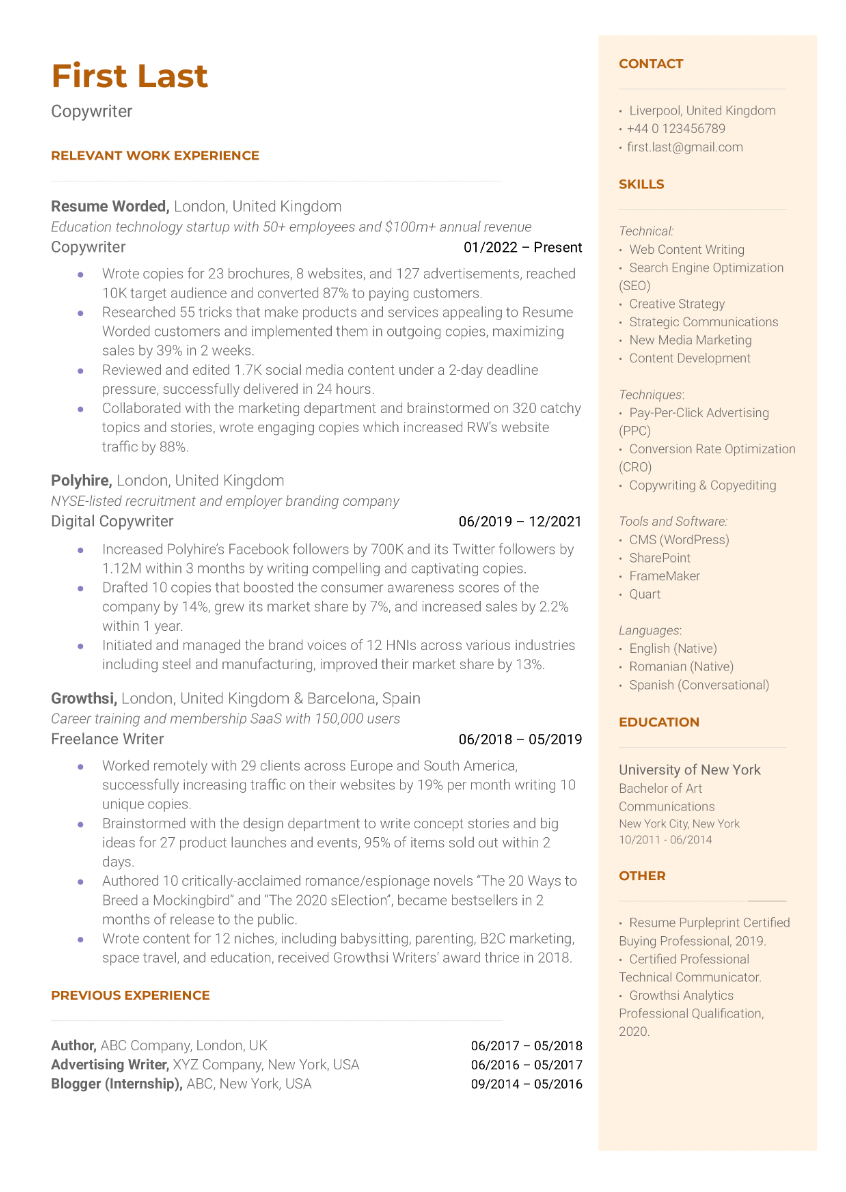Creating a copywriter resume in the incredibly competitive content writing landscape in 2024? I feel your pressure.
But you do not have to dive into the fray unarmed? This article will give you all the information you need to create a stellar copywriting resume — one that will communicate your copywriter skills and experience to hiring managers and get you noticed and hired.
Don't forget to check out the copywriter resume examples so you know what employers are looking for and tailor your resume to meet those expectations.
• If you want to get your foot in the employment door, you need a copywriter resume that represents the absolute best version of you. This article will cover the essentials of an amazing copywriter's resume.
• First, let's hear from a couple of people who hire copywriters: the employers. What do they look for when interviewing copywriters? What should you focus on in your career path and your resume?
• Next, the basic elements of your resume: a summary, list of skills, employment history, awards, certifications, and so on. You must prioritize brevity because your resume must convey all essential information within, ideally, a single page.
• A few tips to further refine your resume and help it stand out: tailor your resume with the right keywords echoing the job description, be razor sharp in your proofreading, and send every resume with a portfolio.
• Finally, three examples of excellent copywriting resumes that every employer would take note of. Use them as models for resume text, formatting, design, stylization, and so on.
• Authory is a dedicated portfolio builder that imports your content from the internet, saves it forever, proves that you do not use AI to write, provides analytics data for your content, and so much more.
What employers are looking for in the best copywriter resumes (a.k.a, what to care about to write a copywriter resume)
Before embarking on resume writing, it's important to consider what hiring managers want. To this end, here are a couple of quotes,
Having been a hiring manager, I can say that it boils down to two things (for me, anyway):
The degree. Did they study writing, English, marketing, or anything similar? I once had a woman with a history degree apply for a copywriting job. She had all the determination and commitment, but studying history doesn't focus your efforts on writing copy that sells a product. And her offer of "I'm a fast learner" didn't carry any weight either. (NOTE: If you don't have a 4-year degree, then take a lot of evening classes in copywriting/marketing, etc.)
How much they've actually written. I want to see good (or decent, anyway) copy that is designed to sell, and I want the writer to be able to explain why he/she wrote it a certain way, and what the results were. Diversity in copy is good too: web pages, emails, print ads, etc. **
— Source
Whenever I evaluate a copywriter candidate, I look at a few things: first, I look for examples of results — how their excellent copy improved conversions or other measurable metrics; second, I look for examples of well-written copy — how well-crafted the ad or email copy was; and finally, I look through their work history to see if the candidate studied (either formally or via certifications) and worked in writing and writing-adjacent fields.
So, it’s a great idea to include aspects of the above in your copywriter résumé, as much as possible. To summarize it into a “template” format, I’d basically include: • work examples that have driven results; • excellent copy examples; • work experience and education qualifications that prove that you’ve studied and/or worked in writing.
— Protim Bhaumik, Marketing Consultant & Fractional CMO for early-stage startups.
Now, let's move on to resume writing elements and tips.
What goes into a copywriter resume
A strong copywriter resume includes the following essential elements:
A resume summary
Think of this as a cover letter for your resume.
This is what the client will see right after your name on your professional resume. In about 2 to 4 sentences, mention your skills, professional experience, and accolades. This is the client's first introduction to you, so highlight only what is most relevant.
You don't have to detail anything at this point. The resume will contain sections with bullet points that go deeper into your relevant experience in previous roles and skills. Just put your absolute best foot forward.
If you've read the job description, you have some idea what the client wants in their employee. Tweak the resume summary to appeal to those qualities. For example, if they are looking for someone with writing skills and a working knowledge of SEO, start your summary with something like: "SEO writer with 5+ years of experience in the B2B market."
List of skills
In the skills section, you qualify the specifics of what you bring to the table — your key skills or top skills. What kind of copy do you write? Advertising copy? Web copy? UI/UX copy?
Define the range of your writing skills. Talk about what you specifically have brought to your writing projects. Outside of just writing, clients also look for research skills, an understanding of SEO, the ability to interact with SMEs, and so on.
Copywriters are expected to interact with clients, so play up your soft skills and communication skills as well.
While your creativity is what gets you hired, keep the resume as straightforward as possible. Your writing portfolio will allow you to be more creative.
Work experience (employment history)
List all your previous roles and jobs i.e., your employment history as a skilled copywriter. Lead with your achievements at every job: "worked on three campaigns to push a 40% increase in website traffic within 6 months," for example. Show that your writing experience involved real results and led to a proven track record of success and competence.
Statements like this are the easiest way to convey your skills and expertise quickly. Remember to mention instances of effective collaboration and resourcefulness you may have demonstrated to get the job done.
If you've trained other people (say, as a senior copywriter), highlight that up front and center. Highlight job titles, employers, tenures, and duties for each role.
Education & achievements
You still need a college degree to get your foot in the door for most jobs. Mention the degree in your copywriter's resume, especially if it’s in related fields like English, journalism, or some other humanities. Degrees in marketing or communication also go a long way in raising your employability.
Depending on what hiring managers require, you should mention your grades, college/university name/ scholarships, and so on. If you've won any awards, be sure to talk about them too.
Outside of your college degree, consider picking up relevant skills like SEO, email marketing, technical skills, and so on.
Bonus tips for resume writing
Tailor your "writing experience" section to each client
This is the most essential of resume tips.
I've already mentioned using specific keywords in your resume. Additionally, when sending your work history, rearrange it or reword it to appeal to the client at the end of your email. As far as possible, echo some of the words in the job description in your work history.
Every employer is looking for a writer who instantly "gets it." By echoing the language of the job description, you get closer to being considered such a candidate.
Proofread your resume
You can't create compelling content with typos all over the place. If your resume is not error-free, you won't even be able to showcase your writing in your portfolio. Your turn will be over immediately.
Before you submit a resume, proofread it three times. No spelling errors, grammatical mistakes, and formatting inconsistencies. Your resume format and content must be pristine. Have a friend proofread after you've done so. The errors will always show up easily for a second pair of eyes.
Always send a resume with a portfolio
Do this even if the clients do not specifically ask for it. Employers want to see where you've worked and then gauge the quality of your content writing. Don't wait for the client to email/call back and ask for it. This might sound like common knowledge, but it was a common mistake I (and quite a few of my peers) made in my job search.
Looking for a copywriter resume example? Here are three to inspire you.
Carrie Jameson

Using your headshot in your resume is not necessary, but it’s always a great touch. If you have an eye for color, you can brighten things up a bit, so to speak. But be careful not to use garish tones.
A one-pager is easy to read and quick to skim through, so whatever format you use, ensure that it ties everything up in a single page.
Copywriter Resume #1

Notice the use of multiple colors, spacing, and font size to include ample information in a single page. Nothing looks cluttered, and yet everything that needs to be conveyed fits into the page.
Copywriter Resume #2

This is the most common yet usable resume format you'll come across. It's perfectly adequate and will get the job done for any copywriting job you apply for. However, if you do have the ability, you can use simple colors and text placement to direct the reader's attention to certain parts of your resume.
Authory: a dedicated portfolio builder that does most of the work
The best resume is one that is backed up by an excellent portfolio showcasing your writing samples. This section will introduce you to a tool that helps you set up a portfolio to demonstrate your writing. While there are many portfolio builders out there, Authory stands out by building your portfolio for you.
When you sign up for an Authory account (for free), you get:
A self-updating portfolio (no need to keep adding new work manually)
Authory will AUTOMATICALLY import a copy of every bylined piece from every site into its database. You don't have to track down links to your published work (especially older pieces). As long as you remember the URL of the site where your work exists, Authory will collate all your content for you in one dashboard.
Automated backups (never lose your content, ever)
All the content that Authory imports from different sources is saved permanently. Even if the original website where it's published goes defunct for any reason, you'll always have a copy safely stored on Authory's server. All backups are in the original format — text and/or media. No screenshots.
Continued importing of past and future content (less effort for a 100% updated portfolio)
Once you enter a source, Authory won't just import your existing publications. Anything you publish on the same site (after you've fed its URL into Authory) in the future will also be imported automatically. In other words, Authory will import your past and future content.
Authory also sends email notifications for every new piece it imports, so you'll always know if something you submitted has been published.
Authory has been chosen by quite a few well-known writer, people who could have picked any tool in the world. There's six-time Emmy award winner David Pogue, Steven Levy, Editor at Large at WIRED, and Brian Fung, a Technology Reporter at CNN, to name a few.
Get started with Authory for free and see for yourself what works for you!


